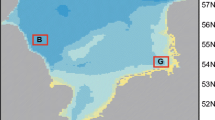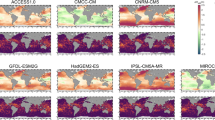Abstract
The multi-decadal wave conditions in the North Sea can be influenced by anthropogenic climate change. That may lead to the intensification of wave extremes in the future and consequently increase risks for the coastal areas as well as for on- and offshore human activities. Potential changes caused by alteration of atmospheric patterns are investigated. Four transient climate projections (1961–2100), reflecting two IPCC emission scenarios (A1B and B1) and two different initial states, are used to simulate the wave scenarios. The potential wind-induced changes in waves are studied by comparing future statistics (2001–2100) with the corresponding reference conditions (1961–2000). Generally, there is a small increase in future 99th percentile significant wave height for most eastern parts of the North Sea towards the end of the twenty-first century. This small increase is superimposed by a strong variability of the annual extremes on time scales of decades. Opposite to the differences in wave height, the change in wave direction to more waves propagating east shows less decadal variability and is more uniform among all realizations. Nevertheless, temporal and spatial differences of the wave height in the four climate projections point to the uncertainties in the climate change signals.











Similar content being viewed by others
References
Bengtsson L, Hodges KI, Roeckner E (2006) Storm tracks and climate change. J Clim 19:3518–3543. doi:10.1175/JCLI3815.1
Bergenhagen J, Döhring R, Fock HO, Kloppmann MHF, Pedersen SA, Schulze T (2010) Decision bias in marine spatial planning of offshore wind farms: problems of singular versus cumulative assessments of economic impacts on fisheries. Mar Policy 34:733–736. doi:10.1016/j.marpol.2009.12.004
Bundesamt für Seeschifffahrt und Hydrographie (2013) Bundesfachplan Offshore für die deutsche ausschließliche Wirtschaftszone der Nordsee 2012 und Umweltbericht BSH Nr. 7601. http://www.bsh.de/de/Meeresnutzung/BFO/Dokumente/BSH_BFO-Nordsee2012-Netzplan_Internet.pdf
Casas-Prat M, Sierra SP (2012) Trend analysis of wave direction and associated impacts on the Catalan coast. Clim Change 115:667–691. doi:10.1007/s10584-012-0466-9
Cieślikiewicz W, Paplińska-Swerpel B (2008) A 44-year hindcast of wind wave fields over the Baltic Sea. Coast Eng 55(11):849–905
de Winter RC, Sterl A, de Vries JW, Weber SL, Ruessink G (2012) The effect of climate change on extreme waves in front of the Dutch coast. Ocean Dyn 62:1139–1152. doi:10.1007/s10236-012-0551-7
de Winter RC, Sterl A, Ruessink G (2013) Wind extremes in the North Sea Basin under climate change: an ensemble study of 12 CMIP5 GCMs. J Geophys Res Atmos 118:1601–1612. doi:10.1002/jgrd.50147
Debernard J, Røed L (2008) Future wind, wave and storm surge climate in the Northern Seas: a revisit. Tellus A 60(3):427–438. doi:10.1111/j.1600-0870.2008.00312.x
Dreier N, Schlamkow C, Fröhle P (2011) Assessment of future wave climate on basis of wind-wave-correlations and climate change scenarios. J Coast Res SI 64:210–214. ISSN 0749–0208
Gaslikova L, Grabemann I, Groll N (2013) Changes in North Sea storm surge conditions for four transient future climate realizations. Nat Hazards. doi:10.1007/s11069-012-0279-1
Grabemann I, Weisse R (2008) Climate change impact on extreme wave conditions in the North Sea: an ensemble study. Ocean Dyn 58:199–212. doi:10.1007/s10236-008-0141-x
Hemer MA, Wang XL, Weisse R, Swail VR (2012) Advancing wind-waves climate science: the COWCLIP Project. Bull Am Meteorol Soc 93:791–796. doi:10.1175/BAMS-D-11-00184
Hollweg H, Böhm U, Fast I, Hennemuth B, Keuler K, Keup-Thiel E, Lautenschlager M, Legutke S, Radtke K, Rockel B, Schubert M, Will A, Woldt M, Wunram C (2008) Ensemble simulations over Europe with the regional climate model CLM forced with IPCC AR4 global scenarios. Technical report 3. Support for Climate- and Earth System Research at the Max Planck Institute for Meteorology, Hamburg. ISSN 1619–2257
Houghton J, Ding Y, Griggs D, Noguer M, van der Linden P, Dai X, Maskell K, Johnson C (eds) (2001) Climate change 2001: the scientific basis. Contribution of working group I to the third assessment report of the intergovernmental panel on climate change. Cambridge University Press, Cambridge
Lowe JA, Howard T, Pardaens A, Tinker J, Jenkins G, Ridley J, Leake J, Holt J, Wakelin S, Wolf J, Horsburgh K, Reeder T, Milne G, Bradley S, Dye S (2009) UK climate projections science report: marine and coastal projections. Met Office Hadley Centre, Exeter. ISBN 978-1-906360-03-0
Marsland S, Haak H, Jungclaus J, Latif M, Röske F (2003) The Max-Planck-Institute global ocean/sea ice model with orthogonal curvilinear coordinates. Ocean Model 5:91–127
Nakicenovic N, Swart R (eds) (2000) Special report of the intergovernmental panel on climate change on emission scenarios. Cambridge University Press, Cambridge. http://www.ipcc.ch/pub/reports.htm
Pinto J, Ulbrich U, Leckebusch G, Spangehl T, Reyers M, Zacharis S (2007) Changes in the storm track and cyclone activity in the three SRES ensemble experiments with the ECHAM5/MPI-OM1 GCM. Clim Dyn 29:195–210. doi:10.1007/s00382-007-0230-4
Reistad M, Breivik Ø, Haakenstad H, Aarnes OJ, Furevik BR, Bidlot J (2011) A high-resolution hindcast of wind and waves for the North Sea, the Norwegian Sea, and the Barents Sea. J Geophys Res 116:C05,019. doi:10.1029/2010JC006402
Rockel B, Will A, Hense A (eds) (2008) Special issue regional climate modeling with COSMO-CLM (CCLM), vol 17. Met. Zeitschrift
Roeckner E, Bäuml G, Bonaventura L, Brokopf R, Esch M, Giorgetta M, Hagemann S, Kirchner I, Kornblueh L, Manzini E, Rhodin A, Schlese U, Schulzweida U, Tompkins A (2003) The atmospheric general circulation model ECHAM5. Part I: model description. MPI - Rep 349, Max Planck Institute for Meteorology, Hamburg
WAMDI-Group (1988) The WAM model—a third generation ocean wave prediction model. J Phys Oceanogr 18:1776–1810
WASA-Group (1998) Changing waves and storms in the Northeast Atlantic?Bull Am Meteorol Soc 79:741–760
Weisse R, Günther H (2007) Wave climate and long-term changes for the southern North Sea obtained from a high-resolution hindcast 1958–2002. Ocean Dyn 57:161–172. doi:10.1007/s10236-006-0094-x
Weisse R, von Storch H, Callies U, Chrastansky A, Feser F, Grabemann I, Günther H, Pluess A, Stoye T, Tellkamp J, Winterfeldt J, Woth K (2009) Regional meteorological-marine reanalysis and climate change projections. Results for Northern Europe and potential for coastal and offshore applications. Bull Am. Meteorol Soc 90(6):849–860. doi:10.1175/2008BAMS2713.1
Yin JH (2005) A consistent poleward shift of the storm tracks in simulations of 21st century climate. Geophys Res Lett 32(L18701). doi:10.1029/2005GL023684
Acknowledgments
The authors are thankful to A. Behrens for assistance with the model WAM and to B. Gardeike for assistance with the graphics. The investigation was partly supported in the context of the joint project A-KÜST in KLIFF (Förderkennzeichen VWZN2455, Az. 99-22/07).
Author information
Authors and Affiliations
Corresponding author
Additional information
Responsible Editor: Birgit Andrea Klein
Rights and permissions
About this article
Cite this article
Groll, N., Grabemann, I. & Gaslikova, L. North Sea wave conditions: an analysis of four transient future climate realizations. Ocean Dynamics 64, 1–12 (2014). https://doi.org/10.1007/s10236-013-0666-5
Received:
Accepted:
Published:
Issue Date:
DOI: https://doi.org/10.1007/s10236-013-0666-5




